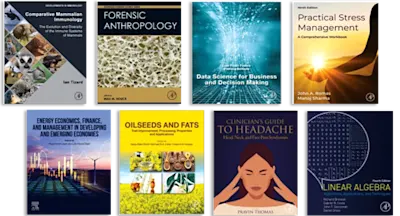
Microbiorobotics
Biologically Inspired Microscale Robotic Systems
- 2nd Edition - February 20, 2017
- Imprint: Elsevier
- Editors: Minjun Kim, Anak Agung Julius, U Kei Cheang
- Language: English
- Hardback ISBN:9 7 8 - 0 - 3 2 3 - 4 2 9 9 3 - 1
- eBook ISBN:9 7 8 - 0 - 3 2 3 - 4 3 0 1 9 - 7
Microbiorobotics: Biologically Inspired Microscale Robotic Systems, Second Edition presents information on a new engineering discipline that takes a multidisciplinary approach… Read more
Purchase options

Institutional subscription on ScienceDirect
Request a sales quoteMicrobiorobotics: Biologically Inspired Microscale Robotic Systems, Second Edition presents information on a new engineering discipline that takes a multidisciplinary approach to accomplish precise manipulation of microscale spaces.
Microorganisms have evolved various mechanisms to thrive in microscale environments and are therefore a useful tool for use in many applications, ranging from micromanufacturing techniques, to cellular manipulation. In the context of microrobotics, biological microrobots can directly harness the microorganisms for propulsive and sensing power and synthetic microrobots can mimic the microorganisms’ motions for effective locomotion.
This second edition covers new advances and insights that have emerged in recent years. Several new chapters have been added on important new research areas, with existing chapters thoroughly revised. In particular, increased coverage is given to fluid dynamics of microswimmers in nature.
- Gives the reader an understanding of the fundamental changes in dynamics and fabrication techniques in the microenvironment
- Offers a unique two-pronged approach to microrobotics from a biological perspective, i.e. bioinspired engineering design of biological systems to accomplish engineering tasks
- Introduces an interdisciplinary readership to the toolkit that micro-organisms offer to micro-engineering
MEMS (Micro Electro-Mechanical Systems) engineers, Mechanical, biomedical and electrical engineers in corporate R&D groups and academia; robotics professionals; graduate students in disciplines listed
Part 1: Introduction
- Motivation for microbiorobotics
- References
- Historical overview
- Low Reynolds number swimming
- Taxis of microorganisms
- Artificial bio-inspired microrobots
- Biological microrobots
- Conclusion
- References
- About this book
- Theoretical microbiorobotics
- Biological microrobots
- Synthetic microrobots
Part 2: Theoretical Microbiorobotics
- Chapter 1: Controlling swarms of robots with global inputs: Breaking symmetry
- Abstract
- 1.1. Introduction
- 1.2. Breaking symmetry
- 1.3. Breaking symmetry with robot inhomogeneity
- 1.4. Breaking symmetry with obstacles
- 1.5. Conclusion
- References
- Chapter 2: Optimization of magnetic forces for drug delivery in the inner ear
- Abstract
- 2.1. Introduction
- 2.2. Ear anatomy
- 2.3. Diffusion model of magnetic particles
- 2.4. Simulations and results
- 2.5. Discussion
- 2.6. Conclusion
- References
Part 3: Biological Microrobots
- Chapter 3: Development of active controllable tumor targeting bacteriobot
- Abstract
- 3.1. Fabrication and surface modification of biocompatible microbeads
- 3.2. Evaluation and control of bacteriobot motility
- 3.3. Motility evaluation of the bacteriobot
- 3.4. In vivo test of the tumor-targeting properties of bacteriobots
- 3.5. Conclusion
- References
- Chapter 4: Control of magnetotactic bacteria
- Abstract
- Acknowledgments
- 4.1. Introduction
- 4.2. Characterization of magnetotactic bacteria
- 4.3. Control of magnetotactic bacteria
- 4.4. Concluding remarks
- References
- Chapter 5: Obstacle avoidance for bacteria-powered microrobots
- Abstract
- 5.1. Introduction
- 5.2. Kinematic model of a bacteria-powered microrobot
- 5.3. Obstacle avoidance approach
- 5.4. Motion under obstacle avoidance
- 5.5. Conclusions
- References
- Chapter 6: Interacting with boundaries
- Abstract
- References
Part 4: Synthetic Microrobots
- Chapter 7: Control of three bead achiral robotic microswimmers
- Abstract
- Acknowledgments
- 7.1. Introduction
- 7.2. Fabrication, properties, and propulsion of microswimmers
- 7.3. Magnetic control system
- 7.4. Modeling and considerations for control
- 7.5. Motion control
- 7.6. Conclusion
- Funding
- References
- Chapter 8: Micro- and nanorobots in Newtonian and biological viscoelastic fluids
- Abstract
- 8.1. Introduction
- 8.2. Self-propelled soft microswimmers and microrobots
- 8.3. Helical propellers in non-Newtonian biological media
- 8.4. Swimming by reciprocal motion in non-Newtonian fluids
- 8.5. Conclusions
- References
- Chapter 9: Magnetic microrobots for microbiology
- Abstract
- Acknowledgments
- 9.1. Introduction
- 9.2. Single microrobot methods
- 9.3. Modeling and control for single magnetic microrobots
- 9.4. Vision-based tracking
- 9.5. Multirobot manipulation
- 9.6. Problem formulation
- 9.7. Simulation
- 9.8. Multirobot experimental results
- 9.9. Conclusion
- References
- Chapter 10: Magnetic mobile microrobots for mechanobiology and automated biomanipulation
- Abstract
- 10.1. Introduction
- 10.2. State-of-the-art: micro-force sensing, mobile magnetic microrobot
- 10.3. Micro-force sensing mobile microrobot
- 10.4. Concluding remarks
- References
- Chapter 11: Magnetic swarm control of microorganisms
- Abstract
- Acknowledgments
- 11.1. Introduction
- 11.2. Materials and methods
- 11.3. Results and discussion
- 11.4. Conclusion
- References
- Edition: 2
- Published: February 20, 2017
- No. of pages (Hardback): 290
- Imprint: Elsevier
- Language: English
- Hardback ISBN: 9780323429931
- eBook ISBN: 9780323430197
MK
Minjun Kim
AJ
Anak Agung Julius
UC